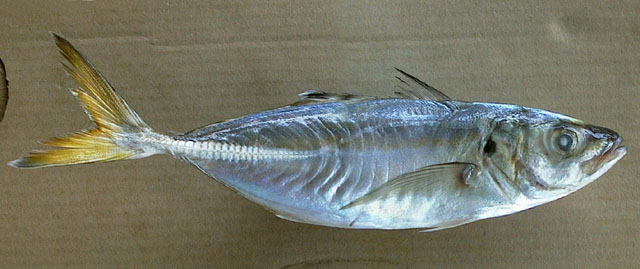| Carangidae (Jacks and pompanos), subfamily: Caranginae |
| 60 cm TL (male/unsexed); max.weight: 1,000.0 g |
|
benthopelagic; brackish; marine; depth range 30 - 200 m |
| Eastern Atlantic: Morocco to Angola (Ref. 4225, 57392), including the Mediterranean along the African coast. Range reported to extend south to Namibia (Ref. 27121). |
|
Dorsal spines (total): 9; Dorsal soft rays (total): 28-32; Anal spines: 3-3; Anal soft rays: 25-28. Diagnosis: body elongate and slightly compressed, its depth comprised from 3.8 to 4.4 times in fork length; eye posteriorly with a well developed adipose eyelid; 2 well separated dorsal fins, 1st with 8 spines, 2nd with 1 spine and 28-32 soft rays; anal fin with 2 detached spines, followed by 1 spine and 25-28 soft rays; last dorsal and anal ray transformed into a partially separate finlet, connected to the preceding ray by a low interradial membrane; pectoral fins short (comprised from 1.0 to 1.2 times in head length); scales small and cycloid; curved part of lateral line with 45-55 scales and 0-3 scutes, straight part with 0-8 scales and 24-32 scutes (Ref. 57392).
Coloration: back brownish to olivaceous, sides light olivaceous to whitish; a narrow yellowish band sometimes extending from head to caudal-fin base; a black spot on upper margin of gill cover; a black blotch with a narrow light distal margin present on second dorsal-fin lobe (Ref. 57392). |
| Form schools. They occur frequently near the bottom, mostly in depths of 30 to 50 m. Also pelagic and found near the surface at times. Entering brackish-water lagoons and estuaries (Ref. 57392). Feed on small fish and invertebrates (Ref. 3195). Spawning grounds are located in shallow waters (Ref. 57055). Eggs are pelagic (Ref. 4233). |
|
Least Concern (LC); Date assessed: 10 May 2013 Ref. (130435)
|
| harmless |
Source and more info: www.fishbase.org. For personal, classroom, and other internal use only. Not for publication.
